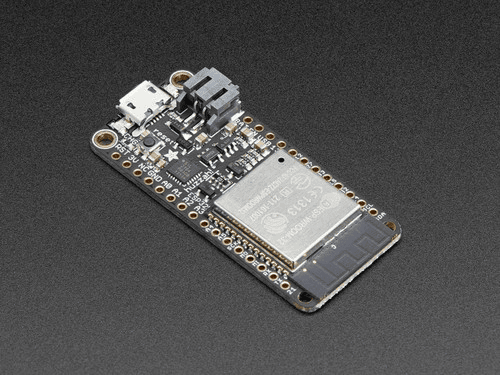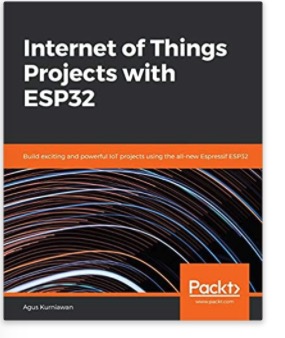Blog
Recent Posts
Adafruit HUZZAH32 ESP32 Feather Board – WiFi, Bluetooth & Battery Power for IoT Projects
Posted by on
 The Adafruit HUZZAH32 Feather Board brings Espressif’s powerful ESP32-WROOM32 module into Adafruit’s popular Feather ecosystem. It offers built-in WiFi and Bluetooth connectivity, dual-core performance, and efficient battery management — making it an excellent choice for Internet of Things (IoT) and embedded applications that demand portability, wireless communication, and reliability.
The Adafruit HUZZAH32 Feather Board brings Espressif’s powerful ESP32-WROOM32 module into Adafruit’s popular Feather ecosystem. It offers built-in WiFi and Bluetooth connectivity, dual-core performance, and efficient battery management — making it an excellent choice for Internet of Things (IoT) and embedded applications that demand portability, wireless communication, and reliability.
Compact Power for Wireless Projects
The HUZZAH32 is based on the ESP32 dual-core Tensilica LX6 processor running at up to 240 MHz. It delivers robust computing performance with approximately 600 DMIPS, enabling multitasking, network handling, and real-time control in parallel.
It includes 520 KB of internal SRAM and 4 MB of onboard SPI flash memory, providing sufficient resources for most wireless applications such as environmental monitoring, automation, or control systems.
The integrated 2.4 GHz WiFi (802.11 b/g/n) and Bluetooth (Classic + BLE) support allow for seamless connectivity to networks, mobile devices, and peripherals. Whether you are streaming sensor data, controlling relays, or building wearable prototypes, the HUZZAH32 simplifies wireless integration.
Feather Form Factor and Compatibility
Adafruit’s Feather design emphasizes modularity and expandability.
The HUZZAH32 maintains full compatibility with Adafruit FeatherWings — add-on boards that provide displays, relays, sensors, and communication interfaces.
This makes it easy to build custom IoT systems without soldering complex wiring harnesses or redesigning PCBs.
The board measures approximately 51 mm × 23 mm × 12 mm, small enough for portable and embedded enclosures.
Power Management and Battery Operation
A major strength of the HUZZAH32 lies in its built-in Li-Po/Li-ion charging circuit and 3.3 V low-dropout regulator, allowing flexible power sources:
-
5 V via USB input,
-
3.7 V from a rechargeable Li-Po battery,
-
or both simultaneously, with automatic charging when USB is connected.
The “BAT” pin provides battery voltage output for low-power sensors, while the “USB” and “EN” pins help developers measure and control power consumption.
Although the ESP32 chip supports extremely low-power deep sleep, actual current draw depends on the board’s regulator and charger circuitry. Developers targeting ultra-low-power designs should measure current consumption in their specific setup.
Input/Output Capabilities
The board provides flexible digital and analog interfacing options:
-
12 × ADC channels for analog sensors
-
2 × DAC outputs for analog signal generation
-
Multiple UART, SPI, and I²C interfaces
-
10 × capacitive touch inputs
-
PWM outputs on most pins for LED or motor control
It also includes a built-in Hall sensor and an ultra-low-noise amplifier, expanding its potential for sensor-based projects.
Because not all ESP32 features are preconfigured in the Arduino environment, users who need additional serial ports or advanced peripherals may need to modify their code or use the Espressif ESP-IDF for full control.
Software Environments
The HUZZAH32 supports multiple programming options:
-
Arduino IDE: Simplifies setup and programming for hobby and maker projects.
-
ESP-IDF: Espressif’s professional development framework, offering full hardware access and FreeRTOS support.
-
CircuitPython: Adafruit’s Python-based environment for rapid prototyping without compilation.
Example sketches are available for WiFi scanning, web servers, Bluetooth beacons, and low-power modes, helping users get started quickly.
Wireless Connectivity
The integrated 2.4 GHz WiFi radio supports both client and access-point modes, making it suitable for direct device-to-device or networked communication. The onboard PCB trace antenna delivers solid range for most applications, but placement and orientation affect signal quality — best results are achieved with minimal metal nearby.
Bluetooth Classic and BLE functionality open further opportunities, such as wireless data transfer, smartphone control interfaces, or sensor beacons.
Practical Applications
-
IoT Sensor Nodes – For temperature, humidity, or motion sensors sending data to cloud servers.
-
Home and Building Automation – Wireless control of lighting, fans, and security devices.
-
Portable Data Loggers – Battery operation with integrated charging for remote monitoring.
-
Prototyping with FeatherWings – Rapid expansion through compatible add-on boards.
-
Educational and Research Projects – Ideal for experimenting with wireless networking and microcontroller programming.
Performance Notes and Limitations
-
Operates exclusively at 3.3 V logic levels; connecting 5 V peripherals can damage the device.
-
The PCB antenna limits extreme range; external antenna versions are better suited for long-distance communication.
-
Deep-sleep current is higher than bare ESP32 modules due to additional components.
-
4 MB flash memory may be insufficient for very large applications or multiple OTA update images.
-
Advanced users may benefit from ESP-IDF to utilize dual-core multitasking and real-time scheduling.
Getting Started Tips
-
Install the ESP32 board package in the Arduino IDE.
-
Select Adafruit HUZZAH32 from the Tools → Board menu.
-
Upload the Blink example to verify setup.
-
For battery use, connect a 3.7 V Li-Po via the JST connector.
-
Use 2.4 GHz WiFi networks; 5 GHz bands are not supported.
-
Keep the antenna area clear of metal or conductive surfaces.
For long battery life, disable unused peripherals and make use of deep sleep cycles between transmissions.
Conclusion
The Adafruit HUZZAH32 Feather Board strikes an excellent balance between performance, power efficiency, and modularity.
Its dual-core processor, built-in WiFi and Bluetooth, and FeatherWing compatibility make it one of the most versatile development boards for IoT and embedded design.
Whether you’re building a battery-powered environmental sensor, a wireless control module, or a portable prototype, the HUZZAH32 provides a dependable foundation backed by Adafruit’s strong documentation and community support.
Product Summary
-
Processor: Dual-Core 240 MHz LX6
-
Memory: 520 KB SRAM, 4 MB Flash
-
Connectivity: WiFi 802.11 b/g/n, Bluetooth Classic + BLE
-
Power: 3.3 V logic, Li-Po charging circuit
-
Dimensions: 51 × 23 × 12 mm
-
Price: $9.95
 Internet of Things Projects with ESP32: Build exciting and powerful IoT projects
Internet of Things Projects with ESP32: Build exciting and powerful IoT projects
The ESP32, a low-cost MCU with integrated Wi-Fi and BLE capabilities, comes with a variety of modules and development boards for building IoT applications efficiently. Wi-Fi and BLE are standard network stacks for Internet-of-Things applications providing cost-effective solutions for your business and project requirements.
This book is a fundamental guide for developing ESP32 programs and starts by explaining GPIO (General Purpose I/O) programming with sensor devices. The reader gets up to speed with ESP32 development through several IoT projects such as weather stations, sensor loggers, smart homes, Wi-Fi cams, and Wi-Fi wardriving. The reader learns how to use ESP32 boards to facilitate interactions between mobile applications and cloud servers, such as AWS.
By the end of this book, you'll have learned how to control a range of IoT projects using the ESP32 chip.
Raspberry Pi PICAN2 Functionality Test With Two PICAN2 HATs
The following is yet another post on testing the PICAN2 - CAN Bus Interface for the Raspberry Pi, however, with a different approach. In this case, we utilize two identical PICAN2 boards and connect them per the CAN Bus (CAN_H to CAN_H, CAN_L to CAN_L) as shown in the image above.In the past, we have [...]
SAE J1939 Programmable Data Traffic Simulator For Generating Diesel Engine Signals (PGNs)
The following represents an update on our current development activities, in this case the jCOM.J1939 Programmable Data Traffic Simulator (a first prototype is shown in the image to the left).In short, the plan is that the device is being set up by means of a Windows software and then runs the programmed PGNs (Parameter Group [...]
CAN FD To USB Gateway Project With Teensy 3.2 And Microchip MCP2517FD CAN FD Controller
Our Teensy 3.2 With CAN FD Breakout Board provides all the components needed to create your CAN FD to USB-Micro Gateway. The board comes with the Microchip MCP2517FD CAN FD controller, while the Teensy 3.2 provides the USB connection. It also has an onboard 5 VDC regulator and reverse-voltage protection. The MCP2517FD is a cost-effective and small-footprint CAN [...]
SAE J1939 Monitor, Analyzer, And ECU Simulator For Windows - New Byte & Bit Editing Mode
The jCOM1939 Monitor Software by Copperhill Technologies is the ideal software tool for monitoring, analyzing, and simulating SAE J1939 data traffic. The program links to our jCOM.J1939.USB ECU Simulator Board that operates as an SAE J1939 to USB (or UART) gateway. This comprehensive and easy-to-use, easy-to-understand Windows software illustrates not only SAE J1939 data traffic; it also allows the [...]
Controller Area Network (CAN Bus) - Physical Layer And Bus Topology
The following is an excerpt from A Comprehensible Controller Area Network by Wilfried Voss. The ISO/OSI Reference Model specifies seven levels starting with the physical connection up to the actual user application, i.e., the Application Layer. The standard CAN Bus implementation neglects the connection between the Data Link Layer and the Application Layer to save on relevant memory resources [...]
CAN Bus Over Ethernet Interface For Internet-of-Things (IoT) Applications
The EtherCAN HS by Kvaser is a real-time Ethernet-to-CAN gateway interface that, when connected over the Internet to an Ethernet-equipped PC, enables remote CAN Bus data access from anywhere in the world. The built-in Power-over-Ethernet eradicates the requirement for a separate power cable when it is not possible to power the device from the CAN Bus network. Kvaser's EtherCAN [...]
Galvanically Isolated CAN Bus Transceivers Protect Networks Against Destructive Energy
High noise levels on a CAN bus network have the potential to destroy CAN bus transceivers. This noise originates mainly from two sources, ground loops and electrical line surges.Protecting a network against this destructive energy requires the galvanic isolation of the CAN bus system from other local node circuitry. For more information on Controller Area [...]
OBD-II Data Logging With Raspberry Pi And PiCAN2 CAN Bus Interface
In all regularity, I receive inquiries from users attempting to connect their Raspberry Pi with PiCAN CAN Bus interface to their vehicle's OBD-II diagnostics port, and the questions asked prompted me to write down the essentials to consider for such a project.Please, note: The following refers to reading CAN Bus data from a vehicle's OBD-II [...]
 Loading... Please wait...
Loading... Please wait...
